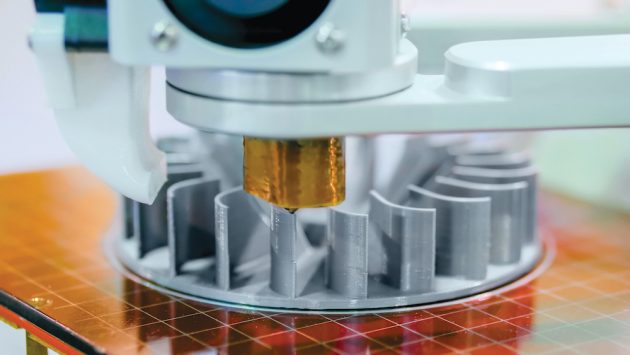
How additive manufacturing software will accelerate the roll-out of products across industries
by Ian Wilding, Managing Partner at Hangar 75, and Brent Wright, Venture Partner, Product Manufacturing
By enabling engineers and designers to reverse-engineer the prototype it’s possible to design a product and then quickly print it out.

3D printer machine printing plastic workpiece look like metal at futuristic technology exhibition – close up shot. 3D printing, 4.0 industrial revolution and manufacturing concept
Photo: Zyabich/Getty Images
3D printing has been on the scene for decades, but reductions in cost and availability have made this technology a commonplace feature across manufacturing, education, and service sectors alike. Also known as Additive Manufacturing (AM), 3D printing as a tool is continuing to develop rapidly. While hardware and printing materials developments helped to chart this rise to ubiquity, new software techniques hold the key to pushing the potential of AM to new heights.
Materials and hardware are nothing unless the software is there to program the tasks accurately and efficiently. Software solutions are unlocking the possibility for more complex designs, larger printing volumes, and increased print success rates—graduating AM/3D from simple prototypes into full product models.
Defining Software in 3D Printing
3D printing software workflows start with good design. In order to better understand this process, let’s take a look at the components of software AM/3D broken down into their parts and purposes.
- Computer-Aided Design (CAD): Software that is used by engineers and designers to digitally define the 3D geometry of a part. CAD software is used to design parts for printing, just like in conventional manufacturing.
- Computer-Aided Engineering (CAE): Also known as simulation, CAE relates to the physical discipline within AM. CAE software is the resource that can help to mitigate quality issues. CAE is not only used to optimize design but also to enhance the manufacturing process itself. With CAE, improved print speed, energy consumption, and material inputs can reduce overall costs through efficiency savings.
- Computer-Aided Manufacturing (CAM): Software to control manufacturing equipment or physical machine tools. With data inputs derived from CAD and CAE, the CAM software creates machine instructions for the 3D printer to follow.
The Advantages of 3D printing in Prototype Development
Thanks to the expanded software capacity of CAD, CAE, and CAM— the ability to use creative geometry is growing, opening the door for innovative product design potential in turn.
Through software, the end-product is in the hands of the designers. By enabling engineers and designers to reverse-engineer the product it’s possible to design it and then quickly print out the prototype. This allows you to get the final product exactly right, with the capacity to confirm the correct mold and drive costs down significantly. Because of this, 3D printers can now go beyond single-use models and have the ability to iterate fast with high tolerance parts. This not only means that the barrier of entry is lowered, but that you can bring a product straight to market.
How This Shift in 3D Printing Will Disrupt the Industry
Certain companies within the 3D printing industry are helping to grow this phenomenon. Plybot, a 3D printing company based in California, is aiming to avoid bamboozling people with the tech jargon, and rather trying to make AM/3D a tool for everyone to use. They do this through their seamless integration of software and approachable terminology. For example, rather than approaching printing with a confusing set of varying dimensions, they outline the size of their printable products by common items that you already know, like “the size of a 24 oz. cup”.
This makes 3D printing accessible to the masses, including those without experience. It allows these individuals to get started—innovating the next generation of AM. Someone with enough interest can now be the idealist, creator, designer, and producer—allowing AM/3D to be in reach for nearly everyone worldwide.
The Future of 3D and AM
The evolving capacity for 3D printing is something for all industries to keep an eye out for. As technology advances, and the focus for this industry is angled more towards design, approachability and capacity for more complex designs—the possibility of what can be made tangible with the click of a button grows.